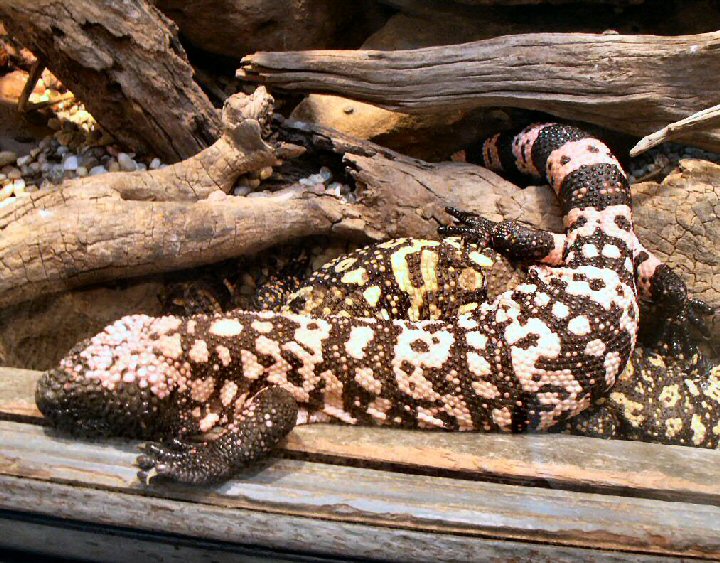 |
 |
Scientific Name: Heloderma suspectum(Class: Reptilia, Order: Squamata, Family: Helodermatidae)
Location at the Zoo: Herpetarium
Physical Characteristics Habitat
The Gila Monster seems to prefer an area which is wet enough to support shrub life. They prefer rocky foothills and desert scrub, but also occur in drier, sandier areas; they avoid open land or agricultural areas. They are nocturnal burrowing lizards and spend a lot of their time underground. They are predominately found in Arizona, New Mexico, Nevada, Utah, and Mexico.
Adaptations:
Gila monsters have three adaptations that enhance their survival in their desert environment: First, they have large bodies, and can consume large amounts of food during a brief period. Second, they need to feed infrequently because they can store fat in their tails. Finally, their metabolic rate is low, so that they burn up their fat reservoirs slowly.
Feeding:Gila monsters leave their burrows in the spring for mating and their major period of food gathering. In the wild they eat small mammals, lizards, frogs, insects, carrion, birds and birds' eggs. They hunt primarily using their sense of taste and smell. They track their prey by flicking their forked tongue to taste the trail of scent particles left by their prey on the ground. The element of surprise is their key to successful hunting.
Gila Venom:
Their venom comes from glands in the lower jaw, and flows into a bite through channels in grooved lower teeth. Although the venom is as toxic as that of a diamondback rattlesnake, this simple delivery system introduces the venom into a wound fairly slowly. The effect of the bite may be intensified as the animal clamps down with his jaws and rolls over, hanging onto its victim and continuing to bite and chew as the venom accumulates in the wound.The venom attacks the nervous system and is strong enough to kill birds and mammals. It has been suggested that the venom of the Gila monster is used more for defense than for feeding.
The bite is described as extremely painful, although pain is initially confined to the area of the bite. Victims may also experience localized swelling, nausea, vomiting, hypertension, weakness, faintness, excessive perspiration, chills, and fever. When bitten, it is important to disengage the lizard as soon as possible. This may be done by placing a strong stick between the bitten part and the back of the lizard's mouth and pushing against the rear of the jaw. If this doesn't work, immersion in water may make it release its hold. The brittle teeth of the Gila monster may remain imbedded in the wound and must be removed by a medical professional.
Gila monsters mate in the spring, but don't lay their eggs -- from 2 to 13 -- until mid to late summer. The eggs are buried about 5 inches below surface and may hatch in the fall, 117 to 130 days after laying, or may overwinter and hatch the following spring.
Reference Links
The Zoological Society of Philadelphia
Dr. Mark Seward's Gila Monster Website